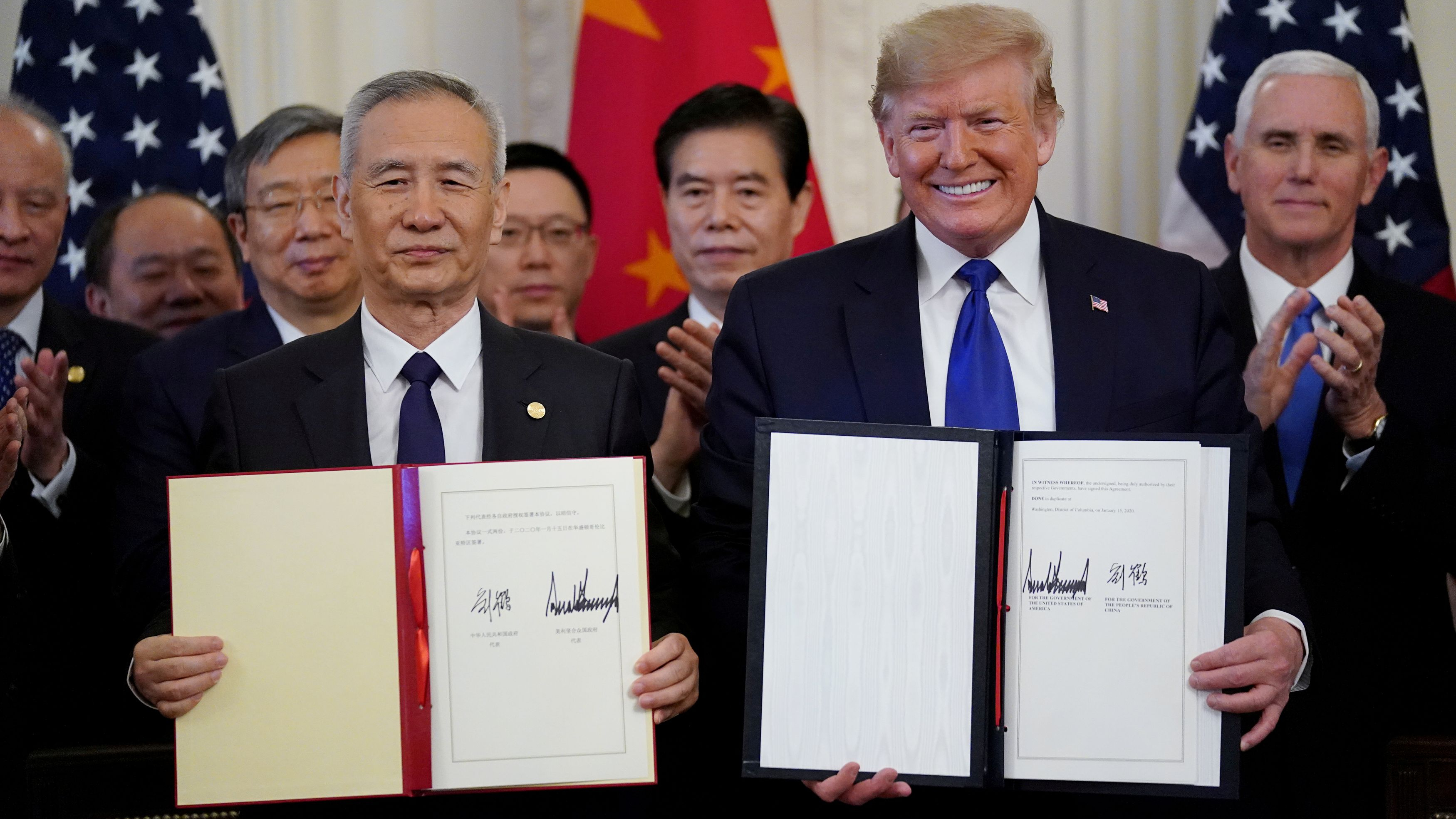
Editor's note: Jia Wenshan is a distinguished visiting professor at China's Shandong University, and a professor at the School of Communication at Chapman University, U.S.. The article reflects the author's views and not necessarily those of CGTN.
At last, to the relief of people in the U.S. and China as well as to the relief of the global community, the phase one trade deal between U.S. and China was finally officially signed in the White House on January 15, 2020, by the U.S. President Trump and Chinese Vice-Premier Liu He, Representative of Chinese President Xi Jinping.
This signing is the result of 22 months' back-and-forth negotiations between the two countries in the background of a tense tariff war initiated by President Trump in early 2018. It has been agreed that China would increase imports from the U.S. by 200 billion U.S. dollars in 2020 and 2021.
These exports consist of 777 billion U.S. dollars of manufactured goods (38.8 percent), 320 billion U.S. dollars of agricultural products (16 percent), 524 billion U.S. dollars of energy products (26.2 percent), and 379 U.S. dollars of services products (18.9 percent) which includes charges for the use of IP, business travel and tourism, financial services and insurance, cloud and related services and other services.
To ease the disputes about IP between the U.S. and China, China has re-affirmed its commitment to enhancing IP protection as it transforms "from a major intellectual property consumer to a major intellectual property producer."
There is no doubt that the deal if implemented to its fullest, would benefit all stakeholders. While the U.S. would reap more tangible benefits, China and the rest of the world would reap more intangible ones.
On the American side, as 50 percent of Americans make investments in the stock market, China's permission to allow more presence of the U.S. capital, financial services, and insurance in China would bring real benefits for both middle-class Americans and the Wall Street alike.
American manufacturers and manufacture workers would benefit as well, as China agrees to buy 777 billion U.S. dollars manufactured goods in the 2020-2021 period. Such a purchase would create thousands of jobs in the manufacturing sectors. With China agreeing to buy 32 billion U.S. dollars' farm products over the next two years, American farmers will reap much bigger profits than before. As a result, all this would translate into a big political win for President Trump as he would be more likely to win more votes from such diverse American constituencies and, in extension, significantly boost his re-election prospect in 2020.

Chinese Vice Premier Liu He stands with U.S. President Donald Trump after signing China-U.S. phase one economic and trade agreement in the East Room of the White House in Washington, U.S., January 15, 2020. /Reuters Photo
Chinese Vice Premier Liu He stands with U.S. President Donald Trump after signing China-U.S. phase one economic and trade agreement in the East Room of the White House in Washington, U.S., January 15, 2020. /Reuters Photo
On the Chinese side, the emerging financial industry would be able to reach a higher level of modernization and globalization as a result of the use of the banking, credit rating, electronic payment, financial asset (distressed debt), insurance, and securities, fund management, and futures services provided by the U.S. Such uses would help foster more competitiveness in China's financial sector, enhance the overall quality of China's financial industry, and encourage indigenous innovations in financial management, particularly in China's ongoing effort to promote RMB internationalization.
Furthermore, China's recommitment to IP protection would be as equally beneficial to China as it would to the U.S. As the deal states, "China believes that enhancing intellectual property protection and enforcement is in the interest of building an innovative country, growing innovation-driven enterprises, and promoting high-quality economic growth."
As for other types of purchases from the U.S. such as farm products, manufactured goods, and energy products, they would not only significantly help reduce the U.S. trade deficit with China, a big source of dispute and a thorn in the U.S.-China relationship; it would also fulfill China's growing consumption needs as it is becoming an internally-driven consumers' market. With RMB 100 trillion GDP and an annual personal income of 10,000 U.S. dollars consisting of 400 million middle-class consumers, China's capacity to consume such purchased goods is immeasurable.
The implementation of the deal would not only benefit the U.S. and China, but it would also contribute "to the harmonious development and expansion of world trade and providing a catalyst to broader international cooperation," as the preamble of the deal states.
This is easy to predict as the U.S. is the largest developed economy, and China is the largest new economy, and the two constitute almost 40 percent of the world economy. A solid trade relationship between the two would constitute the anchor for the world economy, as Chinese Vice-Premier Liu He said in his interview. With the two in sync economically, financially, and eventually politically, the future of the world economy and indeed, the future of the world itself would be much more stable and prosperous.
Having read phase one agreement carefully, particularly Chapter 7 Bilateral evaluation and dispute resolution, I could tell that both parties are sincere about implementing the terms and conditions laid out in the document. My first hope is that this would be the first step towards creating tariff-free trade relations between the U.S. and China. My second hope is that this would not be turned into a vehicle of political expedience for a short-term goal by either party; it would be meant for something larger! Successful implementation of it would not only have huge implications for the future phases of the U.S.-China trade deal, would but also set a good example for the U.S.-China negotiations over other more thorny issues such as security, strategy, and global governance and so on.
(If you want to contribute and have specific expertise, please contact us at opinions@cgtn.com.)